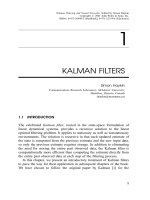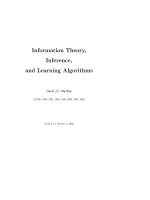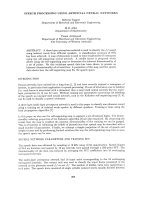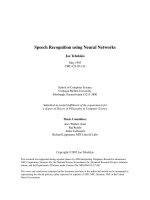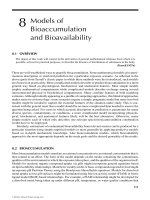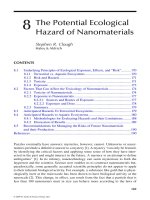Speech recognition using neural networks - Chapter 8 potx
Bạn đang xem bản rút gọn của tài liệu. Xem và tải ngay bản đầy đủ của tài liệu tại đây (13.72 KB, 4 trang )
147
8. Comparisons
In this chapter we compare the performance of our best NN-HMM hybrids against that of
various other systems, on both the Conference Registration database and the Resource Man-
agement database. These comparisons reveal the relative weakness of predictive networks,
the relative strength of classification networks, and the importance of careful optimization in
any given approach.
8.1. Conference Registration Database
Table 8.1 shows a comparison between several systems (all developed by our research
group) on the Conference Registration database. All of these systems used 40 phoneme
models, with between 1 and 5 states per phoneme. The systems are as follows:
• HMM-n: Continuous density Hidden Markov Model with 1, 5, or 10 mixture den-
sities per state (as described in Section 6.3.5).
• LPNN: Linked Predictive Neural Network (Section 6.3.4).
• HCNN: Hidden Control Neural Network (Section 6.4), augmented with context
dependent inputs and function word models.
• LVQ: Learned Vector Quantization (Section 6.3.5), which trains a codebook of
quantized vectors for a tied-mixture HMM.
• TDNN: Time Delay Neural Network (Section 3.3.1.1), but without temporal inte-
gration in the output layer. This may also be called an MLP (Section 7.3) with hier-
archical delays.
• MS-TDNN: Multi-State TDNN, used for word classification (Section 7.4).
In each experiment, we trained on 204 recorded sentences from one speaker (mjmt), and
tested word accuracy on another set (or subset) of 204 sentences by the same speaker. Per-
plexity 7 used a word pair grammar derived from and applied to all 204 sentences; perplex-
ity 111 used no grammar but limited the vocabulary to the words found in the first three
conversations (41 sentences), which were used for testing; perplexity 402(a) used no gram-
mar with the full vocabulary and again tested only the first three conversations (41 sen-
tences); perplexity 402(b) used no grammar and tested all 204 sentences. The final column
gives the word accuracy on the training set, for comparison.
8. Comparisons
148
The table clearly shows that the LPNN is outperformed by all other systems except the
most primitive HMM, suggesting that predictive networks suffer severely from their lack of
discrimination. On the other hand, the HCNN (which is also based on predictive networks)
achieved respectable results, suggesting that our LPNN may have been poorly optimized,
despite all the work that we put into it, or else that the context dependent inputs (used only
by the HCNN in this table) largely compensate for the lack of discrimination. In any case,
neither the LPNN nor the HCNN performed as well as the discriminative approaches, i.e.,
LVQ, TDNN, and MS-TDNN.
Among the discriminative approaches, the LVQ and TDNN systems had comparable per-
formance. This reinforces and extends to the word level McDermott and Katagiri’s conclu-
sion (1991) that there is no significant difference in phoneme classification accuracy
between these two approaches — although LVQ is more computationally efficient during
training, while the TDNN is more computationally efficient during testing.
The best performance was achieved by the MS-TDNN, which uses discriminative training
at both the phoneme level (during bootstrapping) and at the word level (during subsequent
training). The superiority of the MS-TDNN suggests that optimal performance depends not
only on discriminative training, but also on tight consistency between the training and test-
ing criteria.
8.2. Resource Management Database
Based on the above conclusions, we focused on discriminative training (classification net-
works) when we moved on to the speaker independent Resource Management database.
Most of the network optimizations discussed in Chapter 7 were developed on this database,
and were never applied to the Conference Registration database.
perplexity test on training set
System 7 111 402(a) 402(b) 111
HMM-1 55%
HMM-5 96% 71% 58% 76%
HMM-10 97% 75% 66% 82%
LPNN 97% 60% 41%
HCNN 75%
LVQ 98% 84% 74% 61% 83%
TDNN 98% 78% 72% 64%
MS-TDNN 98% 82% 81% 70% 85%
Table 8.1: Comparative results on the Conference Registration database.
8.2. Resource Management Database
149
Table 8.2 compares the results of various systems on the Resource Management database,
including our two best systems (in boldface) and those of several other researchers. All of
these results were obtained with a word pair grammar, with perplexity 60. The systems in
this table are as follows:
• MLP: our best multilayer perceptron using virtually all of the optimizations in
Chapter 7, except for word level training. The details of this system are given in
Appendix A.
• MS-TDNN: same as the above system, plus word level training.
• MLP (ICSI): An MLP developed by ICSI (Renals et al 1992), which is very simi-
lar to ours, except that it has more hidden units and fewer optimizations (discussed
below).
• CI-Sphinx: A context-independent version of the original Sphinx system (Lee
1988), based on HMMs.
• CI-Decipher: A context-independent version of SRI’s Decipher system (Renals et
al 1992), also based on HMMs, but enhanced by cross-word modeling and multi-
ple pronunciations per word.
• Decipher: The full context-dependent version of SRI’s Decipher system (Renals et
al 1992).
• Sphinx-II: The latest version of Sphinx (Hwang and Huang 1993), which includes
senone modeling.
The first five systems use context independent phoneme models, therefore they have rela-
tively few parameters, and get only moderate word accuracy (84% to 91%). The last two
systems use context dependent phoneme models, therefore they have millions of parame-
ters, and they get much higher word accuracy (95% to 96%); these last two systems are
included in this table only to illustrate that state-of-the-art performance requires many more
parameters than were used in our study.
System type parameters models test set
word
accuracy
MLP NN-HMM 41,000 61 Feb89+Oct89 89.2%
MS-TDNN NN-HMM 67,000 61 Feb89+Oct89 90.5%
MLP (ICSI) NN-HMM 156,000 69 Feb89+Oct89 87.2%
CI-Sphinx HMM 111,000 48 Mar88 84.4%
CI-Decipher HMM 126,000 69 Feb89+Oct89 86.0%
Decipher HMM 5,500,000 3,428 Feb89+Oct89 95.1%
Sphinx-II HMM 9,217,000 7,549 Feb89+Oct89 96.2%
Table 8.2: Comparative results on the Resource Management database (perplexity 60).
8. Comparisons
150
We see from this table that the NN-HMM hybrid systems (first three entries) consistently
outperformed the pure HMM systems (CI-Sphinx and CI-Decipher), using a comparable
number of parameters. This supports our claim that neural networks make more efficient
use of parameters than an HMM, because they are naturally discriminative — that is, they
model posterior probabilities P(class|input) rather than likelihoods P(input|class), and there-
fore they use their parameters to model the simple boundaries between distributions rather
than the complex surfaces of distributions.
We also see that each of our two systems outperformed ICSI’s MLP, despite ICSI’s rela-
tive excess of parameters, because of all the optimizations we performed in our systems.
The most important of the optimizations used in our systems, and not in ICSI’s, are gender
dependent training, a learning rate schedule optimized by search, and recursive labeling, as
well as word level training in the case of our MS-TDNN.
Finally, we see once again that the best performance is given by the MS-TDNN, recon-
firming the need for not only discriminative training, but also tight consistency between
training and testing criteria. It is with the MS-TDNN that we achieved a word recognition
accuracy of 90.5% using only 67K parameters, significantly outperforming the context inde-
pendent HMM systems while requiring fewer parameters.
